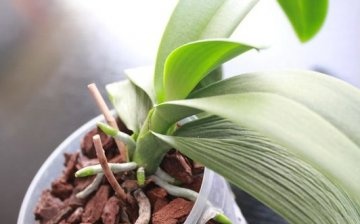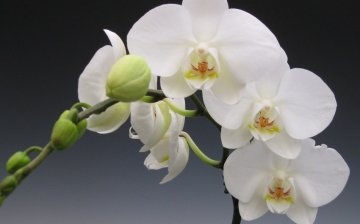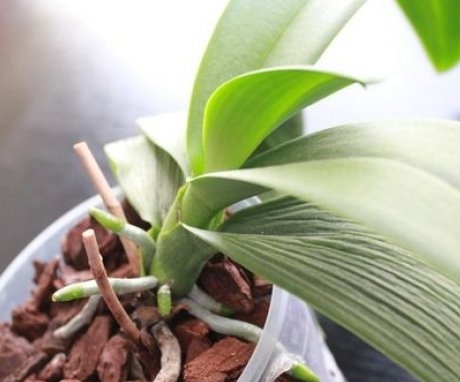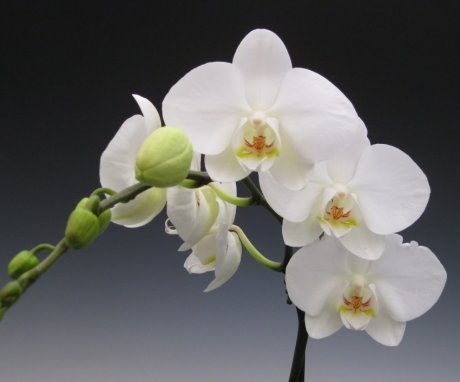Why do orchid leaves wither and what to do to save a flower
Various factors can provoke the wilting of a plant. To fix the problem, you must first identify the reason why the leaves of the orchid wither. Only then can you determine what to do and plan a range of measures to restore the viability of the orchid.
Reasons why orchid leaves wither
Culture care cannot be called unpretentious. The plant requires attention and patience. If at some point the leaves began to lose elasticity, the color changed (leaves turn yellow), urgent measures must be taken to save the orchid. To begin with, it is worth identifying the provoking factor that prevents the access of nutrients to the root system.
Temperature
The culture is characterized by increased sensitivity. It reacts to any changes in environmental conditions. When choosing a place for a flower, the window sill and areas that are exposed to direct sunlight are excluded. Due to overheating, evaporation of moisture from the substrate is activated, as a result of which the roots are supercooled and dry out. Moisture deficiency immediately affects the condition of the leaves and buds. They become soft and lifeless.
Reference! At temperatures less than 15 degrees, the flower is supercooled. There is a danger of plant death. The optimal mode for a tropical beauty is 23-26 degrees.
Pests
Insects are considered dangerous enemies of the orchid. Parasites are most often found under the leaves. The main food for them is plant sap. The flower begins to fade due to dysfunction of the vascular system. There is no need to delay processing, the culture may die.
Most often, the plant is affected by the following parasites:
- red flat mite - the place where the insects are located are the upper parts of the leaf (the problem with insecticides cannot be solved, you need to choose preparations of contact-intestinal action);
- mealybug - you can identify the parasite by the plaque formed on the roots and substrate (eliminate the pest by spraying with soapy water or Fitoverm);
- scabbard and pseudo-scabbard - they choose a place to live under the leaves and on the trunk, insects are recognized by a sticky bloom (to combat the scabbard, a contact-intestinal insecticide is used);
- flat beetle or phalaenopsis tick - it is difficult to find due to the hidden location of the population, parasites are located at the base of the leaves (simple means cannot cope with the removal of the tick, the Marshal pro-insecticide is effective);
- spider mite - the insect settles on flowers, under the leaf (the plant is treated with soapy water and insecticides);
- thrips - on the inside of the leaf you can see small dots and strokes (the problem is solved by spraying the flower with Fundazol, Aktellik, Fitosporin, etc.).
You should not hesitate in processing the plant. In just a few days, the pest population will not only destroy the orchid, but also infect other indoor crops.
Diseases
Among the common problems that arise when growing an orchid, there are:
- root rot;
- fusarium;
- viral infections.
One of the symptoms of disease is leaf lethargy. To identify a specific problem, you need to familiarize yourself with the signs of diseases or consult with experienced growers. The plant needs urgent action.
Root problems
Problems with the root system can provoke wilting of leaves. A healthy plant has greenish roots with a light shade. The presence of brown spots signals an initial decay process. The affected roots are unable to absorb moisture. As a result of disruption of the work of blood vessels, the culture loses its vitality.
Overfeeding
Like any indoor plants, the orchid requires regular feeding... Do not overfeed the flower. An oversupply of nutrients is just as dangerous as a deficiency. An abundance of dressings provokes rotting and drying out.
Small capacity
A common cause of leaf wilting is the wrong pot selection. In a small container, the roots lack the freedom to develop. Acidification of the substrate takes place in a large container. In both cases, the risk of root decay increases.
Draft
Airing is necessary for flowers, an inflow of oxygen restores biochemical processes. However, drafts negatively affect the appearance of the leaves. The cold air flow provokes wilting of the plant. Therefore, when choosing a place for an orchid, you need to avoid the area near doors and windows.
Stress
Moving the orchid to another room or moving it negatively affects the flower. This is explained by a change in temperature, humidity and lighting levels. Orchid is a capricious flower. Therefore, he reacts to any changes by dropping buds or inflorescences, wilting leaves.
Lack or excess of moisture
The natural environment of the plant is the tropics. For normal growth, an orchid needs warmth and moisture. Dry air deprives the flower of vitality. However, waterlogging is not a way out of the situation. Only moderate watering provides optimal conditions for crop development.
You should not rely on the irrigation regime of the orchid. It is better to periodically monitor the moisture content of the substrate. It should always be moist, but without stagnant water. The following factors affect the frequency of watering:
- ambient temperature;
- pot parameters;
- looseness of the substrate.
Reference! You need to moisten the plant as the topsoil dries out.
Air must circulate between the roots of the orchid. When the substrate is compacted, this process is disrupted. Therefore, every 2-3 years, the flower is transplanted with the replacement of the filler.
What to do, how to save a flower
You can save the flower if you start processing without delay.
If insufficient moisture is the provoking factor, you need to saturate the root system with water. To this end, it is effective to soak the roots in a solution of succinic acid (0.1%). It takes 40-60 minutes to keep the plant in liquid.
When waterlogged, it is recommended to remove the bush from the substrate and dry the roots. After that, the flower should be transplanted into a pot filled with new loose soil. Subsequently, you need to try to water the orchid in moderation.
If the wilting of the leaves is due to overheating, the pot is moved to another place, away from the sun's rays. To cool the plant, do not spray it with a spray bottle. This procedure provokes tissue death. Watering resumes after the flower has cooled down in natural conditions. Full recovery occurs within 3-4 days.
When overfeeding, you need to transplant the plant into a new substrate. During the transfer of the bush, the root system is examined. Dried or rotten processes are cut off from it.
Withering of leaves against the background of pathological processes in the roots is eliminated by transplanting an orchid. In the process of transferring a flower, it is necessary to remove the root branches, which have dark or mealy spots, growths, a wrinkled surface. Healthy roots have a greenish tint without inclusions and darkening.
To eliminate the pathological environment and prevent the spread of diseases, it is recommended to treat all sections with activated carbon powder. After transplanting, the affected leaves should be wiped with a solution of succinic acid. This will quickly restore tissue elasticity.
What to do if the leaves wither in a blooming orchid
Not all procedures for the regulation of biochemical processes can be done during the flowering period of an orchid. The first thing is to determine the true cause. The natural aging of the plant is not disregarded. Options with insufficient lighting, stress and improper watering are also considered.
Reference! If problems associated with wilting of leaves are identified, other crops should be removed from the orchid. Insulation will help prevent massive indoor plant disease.
Most problems are solved by methods involving a bush transplant. Doing this during the flowering period of the orchid is undesirable. But subject to certain rules and to save the flower, you should not neglect this method.
When transferring a flower, do not cut off dried roots. Only rotten processes are removed. The root system is not unnecessarily injured by cleaning from the soil. It is also not necessary to soak the plant if it dries out. Moisture recovery is carried out gradually. Any drastic changes will provoke the discharge of buds and opened inflorescences.
Preventive measures
The withering of the flower leaves is not threatened in cases where the flowers are properly cared for. Systemic activities include:
- the correct selection of the parameters of the pot when transplanting a plant;
- creating a comfortable temperature for the orchid (22-25 degrees in summer, 16-18 degrees in winter);
- when rearranging the pot, the difference in temperature conditions should not exceed 5 degrees;
- provision of daylight hours 12-14 hours;
- when the flower is located near the windows, shading is created from the sun's rays (in summer);
- irrigation works taking into account the degree of soil moisture;
- regular introduction of dressings containing potassium and iron (twice a month);
- systemic spraying of a flower on hot days (up to 5 times a day);
- exclusion of spraying during flowering.
The main points of prevention are the rules of plant agricultural technology. Therefore, no difficulties should arise with a competent approach to growing orchids.
Related videos:












The orchid does not require frequent watering, because it has aerial roots. Over-watering or not can be determined by the number of large leaves at the base of the flower. If there are 4 of them, then everything is in order, if there are more than four leaves, then watering is excessive, if less, then insufficient.
Most often, in such a situation, problems are either with ventilation, because the plant cannot stand the stuffiness, or with the substrate, because cheap store-bought ready-made soil for orchids is prepared on the basis of ordinary soil.
When we moved to another apartment, out of eight orchids, only two remained, they did not tolerate the change of residence very badly and I could not save them. And the remaining two stopped blooming. Now I buy new young flowers, it is easier for them to adapt.